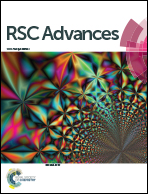Efficient removal of pentachlorophenol from aqueous solution by 4-tert-butylcalix[8]arene modified thermally sensitive hydrogels
Abstract
We prepared poly(N-isopropylacrylamide-co-4-tert-butylcalix[8]arene) (PNIPAM-TBCX) hydrogels by copolymerization of N-isopropylacrylamide (NIPAM) with 4-tert-butylcalix[8]arene (TBCX) to capture hazardous pentachlorophenol (PCP) from aqueous solution. Adsorption experiments showed that the adsorption capacities of PNIPAM-TBCX hydrogels reached 1.96, 2.08 and 2.02 mg PCP per 1 g of hydrogel, while the molar percentage ratio of TBCX in the hydrogels was as low as 0.5%, 0.7% and 1%. The equilibrium adsorption of PCP on the hydrogels was studied using different adsorption models. In addition, the PNIPAM-TBCX hydrogel still retained its performance when regenerated several times by immersing in water at 323 K.
![Graphical abstract: Efficient removal of pentachlorophenol from aqueous solution by 4-tert-butylcalix[8]arene modified thermally sensitive hydrogels](/en/Image/Get?imageInfo.ImageType=GA&imageInfo.ImageIdentifier.ManuscriptID=C8RA00392K&imageInfo.ImageIdentifier.Year=2018)


 Please wait while we load your content...
Please wait while we load your content...